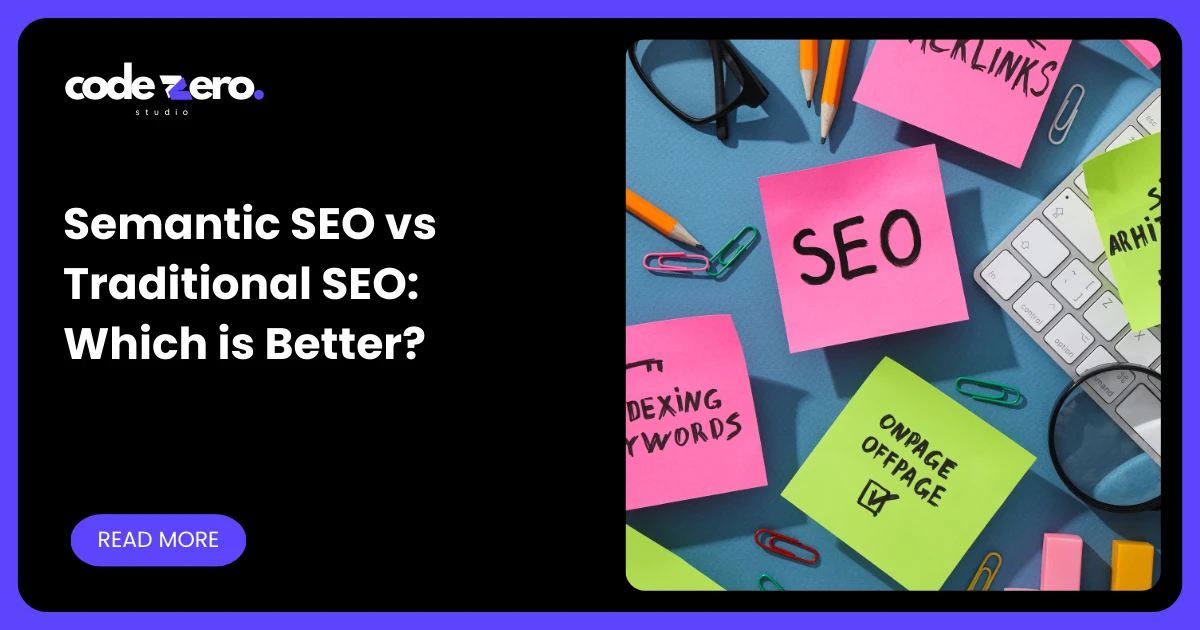When it comes to improving website visibility, there’s an ongoing debate between two key approaches. Both aim to boost rankings, but they do so in different ways. Understanding these methods can help you align your content with what search engines and users are looking for.
Traditional methods focus on keywords and backlinks. They’ve been the foundation of online visibility for years. However, search engines have evolved. Algorithms like Hummingbird and BERT now prioritize meaning and context over just keywords. This shift has given rise to a more modern approach.

This approach organizes content by topic and user intent. It ensures your website answers questions and provides relevant information. By understanding how these methods work, you can create strategies that resonate with both search engines and your audience.
Key Takeaways
- Traditional methods rely on keywords and backlinks.
- Modern approaches focus on meaning and context.
- Search engines like Google prioritize user intent.
- Algorithms such as Hummingbird and BERT have changed the game.
- Understanding both methods can improve your website’s visibility.
Understanding Semantic SEO vs Traditional SEO
The way we approach website optimization has shifted significantly over the years. Two main strategies have emerged, each with its own focus and benefits. Understanding these methods can help you create content that resonates with both search engines and users.
Defining Key Concepts and Approaches
Traditional methods have long relied on exact keywords and optimized pages. This approach aims to match specific search queries directly. While effective in the past, it often overlooks the broader context of user intent.
Modern strategies, on the other hand, go beyond singular keyword optimization. They emphasize context and user intent, using related terms and topic clusters. This ensures your content covers a subject thoroughly, making it more relevant to search engines.

Impact on Search Engine Rankings
Search engines have evolved to prioritize meaning and context. Algorithms now analyze relationships between words and topics, rather than just matching keywords. This shift has made it essential to create content that answers complex queries and provides value.
By focusing on topic clusters and related terms, you can improve your search visibility. This approach aligns with how modern search engines interpret content, helping your website rank higher and attract more traffic.
Historical Overview of Traditional SEO Practices
In the early days of online search, strategies were straightforward and keyword-focused. Websites aimed to rank higher by repeating exact keywords multiple times. This approach, known as keyword density, was a cornerstone of early optimization efforts.
Backlinks also played a crucial role. The more links a site had, the higher it ranked. This led to a focus on quantity over quality, with many websites prioritizing link-building over content value.

Before the Hummingbird algorithm, search engines matched pages with exact keyword usage. If a user searched for “best coffee shops,” only pages with that exact phrase would appear in the results. This limited the relevance of content for more complex queries.
Early websites often used tactics like keyword stuffing and irrelevant backlinks to boost rankings. While these methods worked initially, they lacked depth and context. As search engines evolved, these practices became less effective.
Modern advancements in search technology have exposed the limitations of traditional methods. Today, engines like Google prioritize meaning and context over exact keyword matches. This shift has reshaped how websites approach optimization, moving beyond outdated tactics.
The Rise of Semantic SEO and Its Core Components
Modern search engines now prioritize understanding content over simple keyword matching. This shift has led to the rise of strategies that focus on meaning and context. By organizing information around topics and user intent, websites can provide more relevant answers to queries.

Role of Entities and Context
Entities, such as people, places, and concepts, play a key role in clarifying meaning. Search engines use these to understand relationships between words and topics. For example, if a user searches for “Eiffel Tower,” the engine recognizes it as a landmark in Paris.
Context ensures that related terms are linked, making content more relevant. This approach helps answer complex questions by providing comprehensive information. It also improves the authority of a website by demonstrating expertise on a subject.
Benefits of Topic Clustering
Topic clustering organizes content around a central theme, creating a network of related pages. This structure helps search engines understand the depth of information on a website. For instance, a pillar page about “healthy eating” can link to articles on recipes, nutrition, and meal planning.
This method not only boosts rankings but also enhances user engagement. Visitors are more likely to stay on a website that offers thorough answers to their questions. By grouping words and topics, you create a seamless experience for both users and search engines.
Enhancing User Experience through Semantic Strategies
Creating a seamless browsing experience starts with understanding what users are truly searching for. By aligning content with their intent, you can provide answers that feel personalized and relevant. This approach not only improves engagement but also boosts your site’s visibility in search results.

Aligning Content with User Intent
User intent refers to the reason behind a search query. It can be informational, navigational, or transactional. For example, someone searching for “best coffee shops near me” is likely looking for recommendations, not a history of coffee. By addressing this intent directly, you create a better browsing experience.
To analyze intent, start by examining the context of search queries. Tools like Google Analytics can help identify patterns in user behavior. Once you understand what users are seeking, structure your content to provide clear, comprehensive answers. This clarity keeps visitors engaged and encourages them to explore your site further.
Practical examples make this approach relatable. If your site focuses on travel, a page about “top destinations in Europe” should link to detailed guides on each location. This not only satisfies user intent but also improves your ranking by demonstrating expertise.
Ultimately, a positive user experience translates into higher search rankings. When visitors find what they need quickly and easily, they’re more likely to stay longer and return in the future. By focusing on intent and context, you can create content that resonates with both users and search engines.
Semantic Search and Google’s Algorithm Evolution
Google’s search algorithms have undergone significant changes, reshaping how content is interpreted and ranked. These advancements focus on understanding user intent and delivering relevant answers. By analyzing context and relationships between words, search engines now provide more accurate results.
Influence of Hummingbird and BERT
The Hummingbird algorithm marked a shift from keyword matching to understanding meaning. It analyzes entire queries to provide results that align with user intent. For example, searching for “best way to bake a cake” now returns recipes and tips, not just pages with the exact phrase.
BERT, or Bidirectional Encoder Representations from Transformers, takes this further. It processes words in relation to all other words in a sentence, not just one by one. This helps Google understand complex queries, like “can you get a refund without a receipt?” and provide precise answers.
Insights from the Knowledge Graph
The Knowledge Graph enhances search results by connecting information about people, places, and things. For instance, searching for “Albert Einstein” displays a panel with key facts, related figures, and notable works. This feature improves user experience by offering quick, reliable answers.
By organizing data into entities and relationships, the Knowledge Graph helps search engines understand context. This ensures that results are not only accurate but also comprehensive, covering all aspects of a query.
Advancements in Natural Language Processing
Natural language processing (NLP) has revolutionized how search engines interpret human language. It allows algorithms to understand slang, synonyms, and even incomplete sentences. For example, typing “how to fix a leaky faucet” yields results that address the issue in simple, actionable steps.
These advancements benefit both users and content creators. Users get answers that feel personalized and relevant, while creators can focus on producing high-quality, context-rich content. This alignment between intent and information drives better search rankings and user satisfaction.
Building Comprehensive Content with Topic Clusters
Building a strong online presence requires more than just keywords; it’s about creating a network of interconnected content. Topic clusters and pillar pages are essential tools for organizing information in a way that search engines and users find valuable. By focusing on central themes, you can improve your site’s authority and relevance.
Developing Pillar Pages
Pillar pages serve as the foundation of your content strategy. They cover a broad topic in depth and link to related subtopics, known as cluster content. For example, a pillar page about “healthy eating” might link to articles on recipes, meal planning, and nutrition tips. This structure helps search engines understand the relationships between your pages.
Using natural language and diverse vocabulary is key to connecting these topics. Instead of repeating the same term, incorporate related words and phrases. This approach makes your content more engaging and aligns with how modern search algorithms interpret information.
Organizing content around central themes also addresses user queries comprehensively. When visitors find a pillar page, they can easily navigate to related subtopics. This improves their experience and encourages them to explore your site further.
Practical steps for building topic clusters include identifying a central theme, creating a pillar page, and linking it to relevant subtopics. For instance, a website about travel could have a pillar page on “European destinations” with links to guides on Paris, Rome, and Berlin. This structure not only drives organic traffic but also strengthens your site’s authority.
Well-structured clusters can significantly boost your search performance. By grouping related content, you make it easier for search engines to crawl and index your site. This increases the likelihood of ranking higher for relevant queries.
Comparing Effectiveness: Semantic SEO vs Traditional SEO
Understanding the differences between two major optimization approaches can help you make informed decisions for your website. While one focuses on singular keywords, the other emphasizes broader topics to meet varied user needs. This guide will explore their effectiveness and benefits.
Traditional methods rely heavily on exact keywords and backlinks. For example, a page optimized for “best coffee shops” would rank only if it matched that exact phrase. While this approach worked in the past, it often fails to address complex queries or user intent.
Modern strategies, on the other hand, use context and related terms to provide comprehensive answers. For instance, a page about “coffee culture” might cover brewing methods, popular cafes, and health benefits. This approach ensures content remains relevant and engaging.
One key benefit of the modern method is improved user engagement. By addressing multiple aspects of a topic, visitors are more likely to stay longer and explore related content. This not only boosts rankings but also enhances the overall user experience.
Another advantage is long-term relevance. While traditional methods may require constant updates to match trending keywords, context-based content remains valuable over time. For example, a guide on “sustainable living” will stay relevant as long as the topic remains important.
To illustrate, consider a case study comparing two websites. One used traditional keyword optimization, while the other focused on topic clusters. The latter saw a 30% increase in organic traffic and a 20% boost in user engagement within six months.
In summary, both approaches have their merits, but modern strategies offer greater benefits in terms of engagement, coverage, and long-term relevance. By using tools like topic clustering and context-based content, you can create a more effective optimization strategy for your website.
Implementing Advanced Semantic SEO Strategies
Taking your website’s visibility to the next level requires a deeper understanding of advanced strategies. These techniques go beyond basic optimization, focusing on clarity, context, and user needs. By refining on-page elements and leveraging structured data, you can enhance both navigation and search engine rankings.
Optimizing On-Page Elements
Meta titles, descriptions, and headings play a crucial role in conveying the purpose of your content. A clear and concise meta title helps search engines understand the topic, while a well-crafted description provides context. Headings, such as H1 and H2 tags, break down content into digestible sections, improving readability and relevance.
To optimize these elements, focus on using natural language that aligns with user intent. Avoid keyword stuffing and instead incorporate related terms that enhance semantic clarity. This approach ensures your content resonates with both search engines and users.
Utilizing Structured Data and Internal Linking
Structured data, or schema markup, provides additional context to search engines. For example, adding product details or event information helps search engines display rich results. This not only improves visibility but also enhances user experience by providing quick, relevant answers.
Internal linking strengthens the relationship between pages within your site. By linking related content, you create a network that reinforces topic clusters. This structure helps search engines crawl and index your site more effectively, boosting overall rankings.
Best practices for internal linking include using descriptive anchor text and linking to high-value pages. This approach ensures users can navigate your site seamlessly while improving the authority of your content.
Integrating these techniques into your strategy requires a focused approach. Start by auditing your existing content to identify areas for improvement. Then, implement changes step-by-step, ensuring each update aligns with modern practices. This methodical process will help you achieve better search results and a more engaging user experience.
Measuring SEO Success: Metrics and Performance
Tracking the success of your website’s optimization efforts is essential for long-term growth. By monitoring key metrics, you can understand what’s working and where improvements are needed. Tools like Google Analytics and specialized apps make it easier to gather data and analyze performance.
Organic traffic growth is one of the most important indicators of success. It shows how many visitors are finding your site through search engines. Improvements in keyword rankings also reflect the effectiveness of your strategies. These metrics help you gauge whether your content aligns with user intent.
Page dwell time is another critical metric. It measures how long visitors stay on your site, indicating engagement. A longer dwell time suggests your content is relevant and valuable. Structured data can enhance these metrics by providing search engines with additional context about your pages.
To set up proper tracking, start by defining your goals. Use tools to monitor organic traffic, keyword rankings, and user behavior. Regularly review this data to identify trends and areas for improvement. For example, if a page has low dwell time, consider revising its content to better match user intent.
Real-world examples can guide your strategy. A travel blog might track how many visitors explore multiple pages after landing on a destination guide. This indicates strong internal linking and topic clustering. By continuously refining your approach based on data, you can achieve better results and improve your site’s overall quality.
Conclusion
In today’s digital landscape, creating content that resonates with both users and search engines is more important than ever. While traditional methods focus on keywords and backlinks, modern strategies emphasize context and user intent. This shift ensures your content is not only relevant but also engaging.
Adopting modern approaches can significantly improve user experience and search engine ranking. By addressing search intent and organizing content around topics, you provide comprehensive answers that keep visitors engaged. For example, a blog about healthy living that covers recipes, nutrition, and meal planning offers rich, well-organized information.
Start integrating these practices into your content creation today. Focus on delivering value through context and clarity. This will not only boost your rankings but also create a better experience for your audience.
FAQs
What is the main difference between semantic and traditional approaches?
Traditional methods focus on specific keywords, while semantic strategies emphasize context, relationships, and user intent for better results.
How does semantic search improve user experience?
It aligns content with what users are looking for, providing more accurate and relevant answers to their queries.
Why is topic clustering important in semantic strategies?
It helps organize content around broader themes, making it easier for search engines to understand and rank your site.
How have Google’s updates like BERT influenced search?
Updates like BERT focus on understanding natural language, allowing search engines to interpret queries more effectively.
What role does structured data play in semantic strategies?
Structured data helps search engines better understand your content, improving its visibility in search results.
Can traditional methods still be effective today?
While traditional techniques still have value, combining them with semantic approaches ensures better alignment with modern search algorithms.
How do pillar pages support semantic strategies?
Pillar pages act as central hubs for topics, linking to related content and improving overall site structure.
What metrics should I track to measure success?
Focus on organic traffic, user engagement, and keyword rankings to evaluate the effectiveness of your strategy.
How does semantic search handle user intent?
It analyzes the meaning behind queries, ensuring results match what users are truly seeking.
Why is natural language processing important for search engines?
It allows engines to interpret conversational queries, delivering more precise and helpful results.

